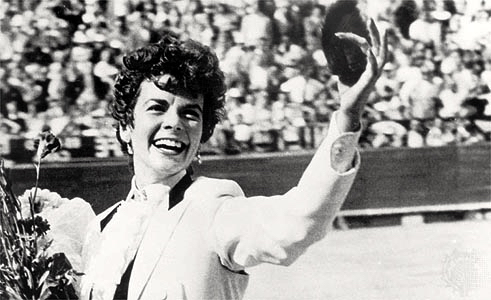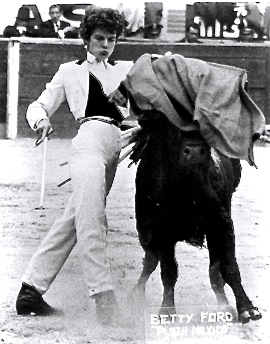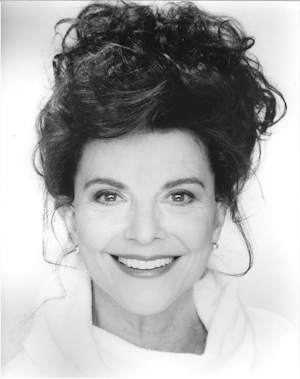Featured Song: "Pasodoble for an American Matador"
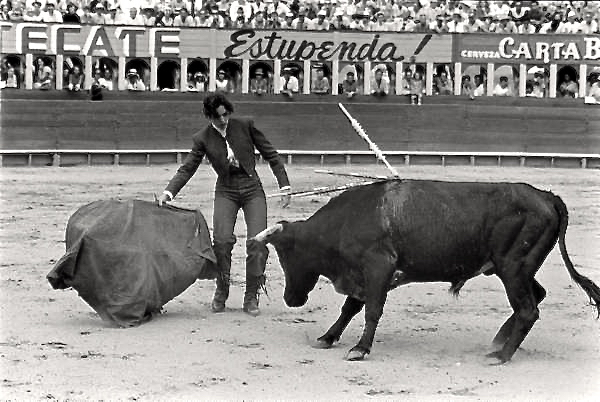 Judging from the title alone, you’d think “Betty Ford” by Mariachi Continental De Miguel Diaz was about a former First Lady. The song is an instrumental, so there are no lyrics telling us a story. The genre, however, gives us a clue to its subject. It’s listed in the Frontera Collection as a pasodoble, the theatrical but graceful style of song typically played at bullfights, especially during the entrance of the matadors.
Judging from the title alone, you’d think “Betty Ford” by Mariachi Continental De Miguel Diaz was about a former First Lady. The song is an instrumental, so there are no lyrics telling us a story. The genre, however, gives us a clue to its subject. It’s listed in the Frontera Collection as a pasodoble, the theatrical but graceful style of song typically played at bullfights, especially during the entrance of the matadors.
Luckily, the scratchy old recording, produced in the 1950s, starts with an announcer telling us exactly for whom the song was written. Speaking in English with a heavy Spanish accent and with a trumpet fanfare in the background, the speaker dramatically declares, “Your attention, please. This pasodoble is dedicated to the great American bullfighter girl, Bette Ford.”
That’s right, a bullfighter who was not only an American (rare enough), but also a woman (not a “girl”). Her matador stage name – or is it “ring” name? – was Bette Ford, not “Betty” as written on the record label by Continental Recordings. (The label was based in Fresno, California, but the song was recorded in Mexico.) 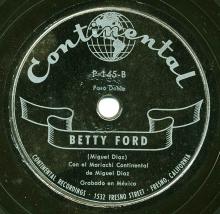

This is yet another example of how the Frontera Collection is not just an archive of old music. It also provides a window on the broader culture, and often an opportunity to learn something new. I had no idea there was an American female bullfighter, much less more than one. The late Patricia McCormick of St. Louis, Missouri, for example, also gained fame in the bullring during the early 1950s, preceding Ford by a few years. They are among 21 female bullfighters, mostly from Spain and Latin America, listed on this Wikipedia page.
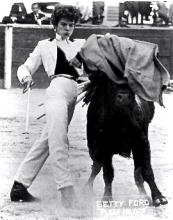 Matador Bette Ford, who is still living, has an alluring story, in part because she was on the verge of a Hollywood film career when she dropped everything and took up bullfighting. She became an international celebrity who hobnobbed with Ernest Hemingway, but her cross-cultural path wasn’t easy. In one interview later in life, she recalled how bullfighting fans actually cheered for the bull to win.
Matador Bette Ford, who is still living, has an alluring story, in part because she was on the verge of a Hollywood film career when she dropped everything and took up bullfighting. She became an international celebrity who hobnobbed with Ernest Hemingway, but her cross-cultural path wasn’t easy. In one interview later in life, she recalled how bullfighting fans actually cheered for the bull to win. “I really was very young and reckless and in retrospect, very lucky,” she told Guernica Magazine in 2011. “There were a lot of people who expected me to be killed. When I started out fighting, promoters used to say, ‘If you want to make money in a border town, get Bette Ford to fight.’ Because Americans would come in droves to see me killed. I’d be down, the bull would be going at me, and the crowd would be shouting, ‘Kill her, bull, kill her.’ They expected me to fail, this American woman, girl almost, who thought she could fight bulls.”
Ford’s real name was Harriet Elizabeth Dingeldein. She was born and raised in McKeesport, Pennsylvania, near Pittsburgh, where she was a high school cheerleader. As a young woman, she moved to New York to pursue an acting and modeling career, posing in ads for major brands and earning nicknames such as the “Jantzen Bathing Suit Girl,” the “Camay (soap) Bride,” and “the Parliament (cigarette) Girl.” She was also a regular on variety shows from the early days of television, hosted by the likes of Jackie Gleason and Jimmy Durante. In New York, she married actor David Ford, and kept his name despite a divorce and two subsequent marriages.
Her life took a fabulous and romantic turn in 1953 when she visited Bogota, Colombia, on a modeling assignment. There she met celebrated Spanish bullfighter Luis Miguel Dominguín, who invited her to watch him perform at a corrida de toros. That encounter inspired her to sacrifice her budding acting career (MGM had offered her a contract) and move to Mexico City to start training as a bullfighter. She debuted in 1955 at the historic Plaza Mexico, the world’s largest bullring. Fans of the sport were instantly enchanted, as one Mexico City critic put it, by the petite American matador who “fights like a man and walks the street like an elegant lady.”
Ford was first drawn to the drama of the bullfight as a girl when she read Ernest Hemingway’s 1932 novel, Death in the Afternoon. Later, in the glow of her bullfighting fame, she found herself socializing with the legendary author and his entourage, including actress Ava Gardner. According to a newspaper account, Hemingway once said of Ford, “She’s the most intelligent woman I’ve ever met and I’ve met a hell of a lot of them."
As might be imagined, her career from the fashion runway to the bloody bullring drew plenty of media attention at the time, including a two-part feature story in the Village Voice in 1955, the inaugural year of the ground-breaking weekly. A year earlier, Ford was featured in a Warner Brothers documentary titled Beauty and the Bull about her time in Mexico training to be a bullfighter.
Ford also made an appearance on the 1950s television game show What’s My Line? As baby boomers will recall, that was the show where mystery guests signed in and a panel had to guess their occupation by asking questions. A clip of the episode featuring Ford, looking elegant and statuesque in a silky cocktail dress, is available on YouTube.
Despite the ample information about Ford available on the Internet, there is some dispute about when she was born. Her page in Wikipedia cites her birthdate as 1937, which is probably wrong because that would mean she started bullfighting at age 16. The fact is she was already in her 20s when she moved to Mexico to be a matador. Thus, she was probably born in 1931, as the Village Voice indicated at the time.
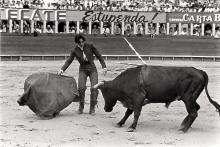 The first installment of the Village Voice article ran on the front page of its edition of December 7, 1955. It appeared under the headline “Moment of Truth” with a picture of Ford being lifted off the ground by a particularly ornery bull. During her Q&A with journalist Gus O’Shaugn, Ford made a short, shocking statement about her love of bullfighting that would haunt her throughout her life:
The first installment of the Village Voice article ran on the front page of its edition of December 7, 1955. It appeared under the headline “Moment of Truth” with a picture of Ford being lifted off the ground by a particularly ornery bull. During her Q&A with journalist Gus O’Shaugn, Ford made a short, shocking statement about her love of bullfighting that would haunt her throughout her life:“Does it bother you to kill?” the interviewer asks.
“I love to kill,” responds Ford.
More than 55 years later, Ford was interviewed again, this time for Guernica Magazine, an online journal of arts and culture based in New York. The interview, conducted at the celebrity’s Toluca Lake home in Los Angeles, ran in 2011, the year before a ban on bullfighting was to take effect in Cataluña, the region of Spain that includes Barcelona where Ford was once gored by a bull.
In the interview, Ford expressed regret that Barcelona’s glorious bullfighting tradition was coming to an end. But she expressed no regrets at all about taking up a sport that is falling out of fashion, even in Spain. And when asked, she clarified that controversial quote from half a century earlier: she wished she had said instead, “I’m good at killing.” That may not sound much better, but it speaks to her original motivation for taking up the matador’s sword and competing in a traditionally male arena.
“I was fascinated with the idea that I could have power in a man’s tradition—that I could appropriate some of that power for myself,” she explained. “For me, at the time, bullfighting was this very spiritual engagement with power, with power and death. You’re pitting yourself against a force that’s stronger than you and then you’re winning or losing.”
Despite close calls (“I’ve been gored, my back’s been broken, my hand was almost ripped off.”), Ford survived about a decade in bullfighting before returning to acting. Her extensive film and TV credits, listed on IMDb, include many appearances on major network shows, including ER, The Fresh Prince of Bel-Air, and the comedy series Cheers. She also co-starred with Clint Eastwood in Sudden Impact (1983) and with Steven Seagal in Marked for Death (1990). Her performance credits include appearances as recent as 2011.
Though her two careers were vastly different in many respects, Ford saw artistic connections between acting and bullfighting.
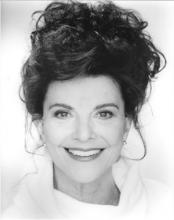 “The transition [to bullfighting] was abrupt to say the least,” she reflected in the Guernica interview. “I had to learn everything from scratch, the most basic of the fundamentals, how to avoid getting killed first of all, also how to handle the fear of getting killed. Even my Spanish was rudimentary at the time. I think the abruptness of the transition, and how little I knew about technique, shaped how I perceived bullfighting as an art form once I was there and in the middle of it.
“The transition [to bullfighting] was abrupt to say the least,” she reflected in the Guernica interview. “I had to learn everything from scratch, the most basic of the fundamentals, how to avoid getting killed first of all, also how to handle the fear of getting killed. Even my Spanish was rudimentary at the time. I think the abruptness of the transition, and how little I knew about technique, shaped how I perceived bullfighting as an art form once I was there and in the middle of it.“I latched onto what was familiar to me as a way of making the transition. And what I latched onto were the elements that stand out if what you mostly know is modeling and acting. The three-act structure of a bullfight, for example … . Also of course the costumery, but mainly the theatrics and the idea that you’re in the spotlight, you and the bull, that there’s a supporting cast around you, and most important, that you’re building toward something through the first and second acts, you’re building to a culmination in the third act. I think that’s one of the reasons that I learned to kill well.”
-Agustín Gurza
Blog Category
Tags
Images

